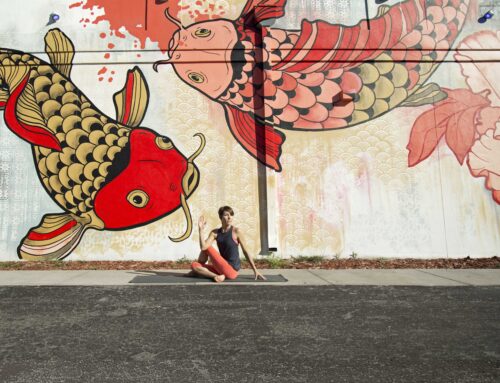 Have you ever had a client that you dreaded seeing the next day? Do you find yourself shrinking away from a student who is overly-chatty? When you are uncertain of how to deal with these individuals, you can find yourself frustrated and energetically drained. This blog post provides numerous solutions to confidently manage challenging yoga clients.
Have you ever had a client that you dreaded seeing the next day? Do you find yourself shrinking away from a student who is overly-chatty? When you are uncertain of how to deal with these individuals, you can find yourself frustrated and energetically drained. This blog post provides numerous solutions to confidently manage challenging yoga clients.
One of my favorite examples of this is someone I’ll refer to as “Yoga Jeff” for the remainder of this article. He was a really nice guy in his late fifties who would attend numerous classes a week. It was obvious to every teacher at the studio that this was Yoga Jeff’s social outlet. He was a widow and wood-worker, so much of his home and work life was spent solo.
The only problem was that Yoga Jeff would chat incessantly when before and after class. He would corner students and talk to them about anything and everything. Teachers would be bombarded with questions after class and Yoga Jeff wouldn’t even be aware of the new group entering the studio for the next one. He was just happy to talk, talk, talk.
Growing up around people-pleasers, I would often internalize the stress in these types of situations. My throat would tighten and my stomach, constrict. It’s like every cell of my being screamed to be out of the situation, but my physical body stayed put. It was miserable.
Then…
Somewhere around college, I learned to find my voice. I found that I could use kind words to set expectations for myself and others during my interactions with them. During this time I also found simple ways to find emotional balance even in those times when my clear communication had fallen on deaf ears.
The blog post comes as a special request from one of my clients, and I think many of us yoga teachers experience these moments. Since I have taught communication techniques over the past ten years, here are some simple and effective ways to handle these situations. This will be the first of a three-part blog series.
Photo Credit: Diane Nicole Photography
ENERGY AND RELATIONSHIPS
You already know that you’re an energetic being. You are breathing and moving today because of the life force, or prana, that is flowing through you. Consider the following wisdom you already have about energy:
Your energy levels are in constant flux. This varies moment-to-moment and day-to-day.
- The more prana you allow and harness, the more alive you feel.
- There are activities and relationships that add energy to your life, and there are people, places and things that reduce your life energy.
- Every decision, whether big or small, affects your energy levels
- If you lose energy over and over again, then your mood and productivity drops.
Thankfully, you practice and teach yoga, which adds vitality to your life. This energetic boost comes not only from body movement, but it occurs any time you feel a positive emotion. When you encounter peaceful and compassionate and kind clients, your energy naturally swells. You feel great around these people. And, you enjoy their company.
On the contrary, there are ways you can cut off the flow of energy from your experience. You can think, speak, and act in ways that are contrary to your moral compass. And a negative emotion always indicates your loss of energy. Those difficult yoga clients can trigger this energetic drain.
PREVENT ENERGY DRAINS
You’ve probably heard the quote, “Holding onto anger is like you drinking poison and expecting the other person to die.” Well, when you hold any negative emotion, you’re actually the one taking the hit. Your mental, physical, and emotional being suffers. Much of the time, the other person is entirely oblivious to your discomfort.
This can be especially true when the person is like Yoga Jeff. They’re really a kind-hearted person, but blissfully unaware of how others respond to them.
Since your goal is to have as much energy as possible each day, you want to make the most of your actions and interactions. Being unprepared to handle challenging yoga clients can make this goal impossible. Thus, it’s essential to have systems in place to deal with these situations before they occur.
The steps provided below to work with challenging clients like Yoga Jeff start broad and become more specific. They start with a gentle nudge and become more direct if he is unable to grasp your message. This same approach will follow suit as we look at angry clients or those know-it-all students in the weeks ahead.
(Please note that if your name is Jeff, I mean no disrespect. These names are simply a hypothetical way to understand how to best deal with these personality types)

Photo Credit: Priscilla Du Preez
COMMUNICATE CLEARLY WITH THIS CLIENT
Yoga Jeff is the overly-talkative, nice person who often uses yoga as a social setting. While he seems harmless enough on the surface, his constant engagement in conversation can be a distraction. You might notice this client just wanting to talk with you. Or, you might observe that Yoga Jeff latches on to any other body in the room to which he can talk. My husband actually calls these types, “cling-ons.”
Since it’s your responsibility as a yoga professional to create a safe, welcoming space for all of your students, keep an eye on the entire room. If you notice people also shying away from Yoga Jeff–moving their mats and starting to avoid him–you’ll also have to use the steps below to bring this issue to his attention.
The Natural Reaction
You probably already shift your body language when you want to end a conversation. Since you want to break rapport, you start with subtle gestures. Your arms get crossed. You look at the clock. Instead of facing the person directly, you turn your body away from them. You might even start multi-tasking so the other person becomes aware you’ve got other things to do.
Since you don’t want to be rude to your yoga clients, we suggest a more direct approach through clear communication. The three options below are a good place to start.
Step 1: The Gentle Nudge
When to use: Yoga Jeff has repeated his talkative behavior more than once, and it’s starting to cause an energetic drain for you or others.
How to approach him if he is bothering only you:
If Yoga Jeff is talking to you before class, then you can directly say, “Jeff, I really appreciate that you’re here and really dedicating yourself to the practice. (Start with a praise and genuine validation of him as a person). Since I want to get a few things in place before class begins, can we table your thoughts until a later time?” (End with a buy-in question. This approach also keeps you in charge of the situation).
If you are cornered after class, you can excuse yourself with other responsibilities and still end with the same question.
How to approach him if he is decreasing enjoyment for others:
Ask if you can speak to him briefly after class. Then, when you have more privacy, you can say, “Jeff, I appreciate you being here and recognize that you’re naturally very social. I just want you to know that many of the students that come to my classes do so because they want some time for introspection. They have busy lives and want some quiet here in the studio. Would you please be willing to minimize the chit-chat when you’re here? Would you be okay with that? (you still want to end with a question to get his agreement)
More often than not, Yoga Jeff will get the hint. If not, move to Step 2.
Photo Credit: Michelangeloop
Step 2: Be direct
When to use: Yoga Jeff has repeated his behaviors, despite your previous conversation with him.
How to approach him:
Ask to speak to Yoga Jeff privately after class. If he can’t right away, then schedule a time before the next class. Then, when you’re alone, you can say, “Jeff, here’s how I feel when you come in for class and want to talk to me. Your social nature pulls me away from my ability to stay centered and prepare for class. This makes me feel stressed. Would you be willing to give me some space when I’m here to teach? I want to give my best to all of my students. Does that make sense?”
If Yoga Jeff often corners you after class, then you can approach it this way: “Jeff, here’s how I feel when you want to talk to me lots after class. I know we talked about this before, but I get anxious when trying to listen to you and close up the studio. If you would like to email me some of your questions, I can respond to you later?”
If Yoga Jeff is still chatting with other people, then you might have to step in again. Repeat the fact that people are often introspective when they visit the studio. Then ask, “Can you please keep your conversations brief and to the point? Do you understand what I’m trying to say?” And, always end with “Thanks for listening.”
The Takeaway
The entire point of your clear communication in these situations is to teach Yoga Jeff to match your energy. You are setting the tone for your classes, and instructing your students how to behave when attending your classes.
NEW STUDENT JITTERS
It’s not uncommon for new yoga students to be nervous. This can sometimes trigger an overly-chatty response in them. To prevent this from happening in the first place, you can put the following systems in place before they arrive at your class:
1) Set your expectations online
Your website is a perfect place to post important content that would set clear expectations for your new students. This can include:
- Yoga etiquette
- What to wear
- When and what to eat before class
- Class/Studio policies
- How to reserve your space in class
- Ways to cancel your existing reservation, and
- How to fill out the Yoga Intake Form and Liability Waiver to participate in yoga
 2) Remind new students about your expectations via email
2) Remind new students about your expectations via email
Once a student has purchased a class or private session, they are part of your email list. If you use an email management software, like MindBody or Drip, you can automatically send customized emails to these clients.
I highly recommend that you remind them of the expectations you have for their participation in yoga. Even if they have read this information on your website, seeing it again in their inbox can further solidify your expectations. .
3) Be specific with your questions
It’s common to ask new students questions like, “Have you practiced yoga before?” or “Do you have any injuries?” This could potentially open up a lengthy conversation in which the client tells you about every single illness and surgery they’ve had in their lifetime. (Think Yoga Jeff personality–nice but often speaking off topic)
Instead, ask a more specific question like, “Have you practiced vinyasa flow before?” or “Do you have any injuries that would hinder your practice today?” This requires them to answer you in a more detailed way, saving you time and energy in the process.
**As a side note here, Yoga Alliance has a different opinion about asking for injuries due to liability reasons. Personally, I find I can better serve my students when I understand their condition and can better help them modify each asana during practice. And, if you have a well-written liability waiver, students are taking their own responsibility for their bodies.
4) Say Thank You
Before new students leave, thank them for coming. Let them know you appreciate the time and courage it took to come to class. You can follow that up with a specific question (to keep them on one subject), or you can simply inquire if they have any questions for you. This would indicate you are ready to help them, but also allow you to do some of the talking and keep the conversation to a shorter length.
Keep in mind that you can always refer them to your website or other resources online to answer their questions. Or, you can request they email you directly, as you often can’t address their inquiries on the spot.
Photo Credit: Ember and Earth Photography
PUTTING IT TOGETHER
As a yoga professional, you work with a diverse population. Some clients are naturally positive and boost your energy. But the difficult ones can leave you feeling frustrated and energetically drained. When you use clear communication to set expectations before you interact with your students–and take leadership during conversations with them–you can manage challenging yoga students with grace and ease. And, you’ll be able to quickly rebound to an energized state should you notice yourself unable to stay aligned in any given situation.
Join us next week as we provide strategies to deal with angry clients. On a different subject, we’ll also cover the importance of using quality photos to build your yoga business.









Leave A Comment